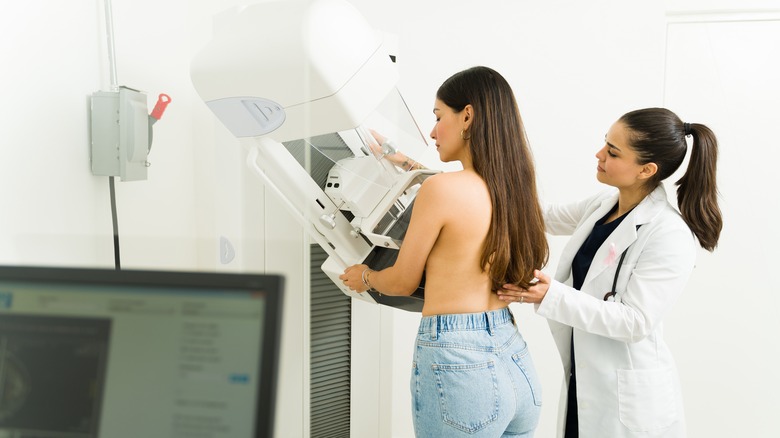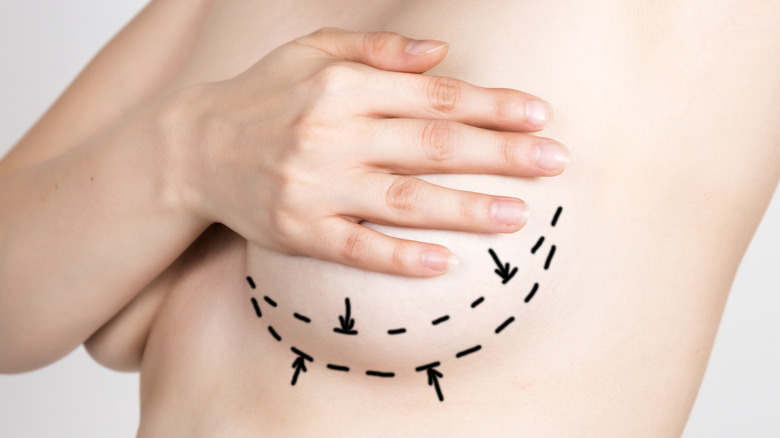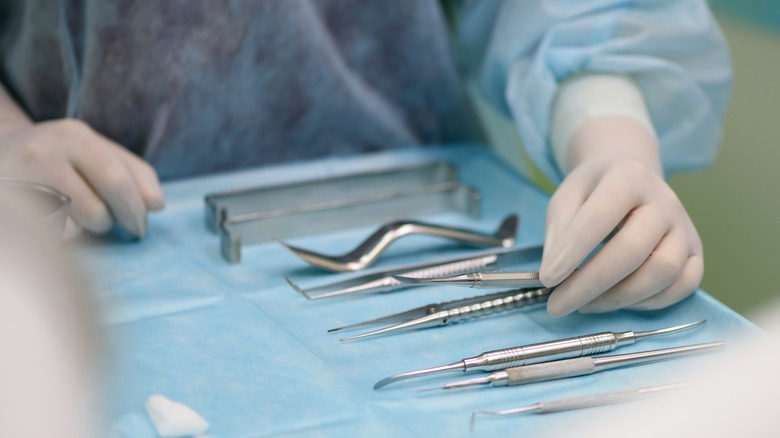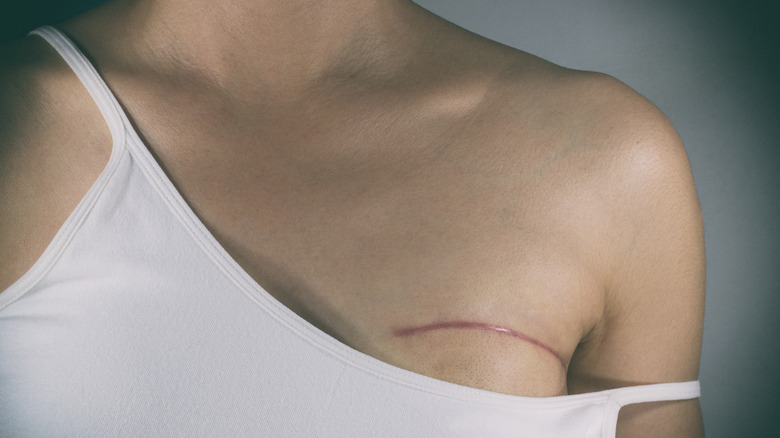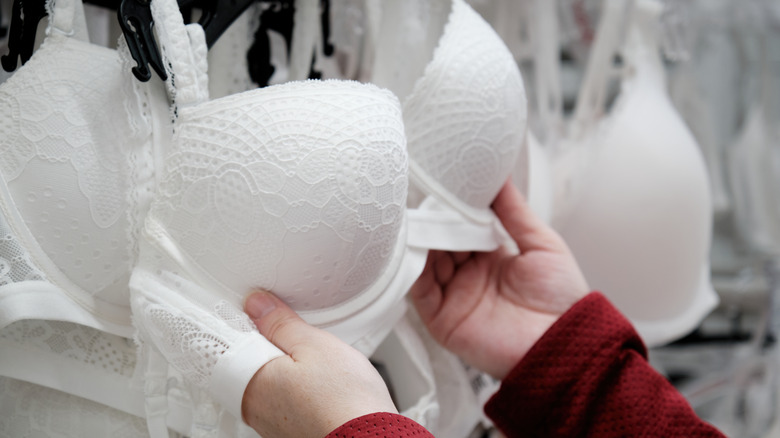The Ultimate Guide To Breast Lifts
You've undoubtedly heard about breast lift surgery before, and if you're reading this, you've likely taken a more vested interest in this cosmetic procedure. It's normal for women to experience changes in their breasts as they age — women's bodies tend to go through a lot. Not only do the breasts experience changes when a woman is pregnant, but they also work really hard during pregnancy to produce milk for the newborn baby. Needless to say, we can't expect them to look the same in our 40s as they did in our early 20s and 30s, and that's okay.
Luckily, there is such a thing as breast lift surgery. Referred to as mastopexy in the medical world, this surgery accomplishes exactly what the name suggests: It lifts and reshapes breasts that have lost their elasticity and perkiness. Healthline notes that the surgery can also change the appearance and size of the area around the nipple, called the areola. Breast lift surgery can make a massive difference in the appearance of the breasts, and some women opt to include a breast augmentation procedure along with their breast lift surgery to make their breasts appear more prominent.
Plastic surgery is becoming increasingly popular, and if breast lift surgery interests you, you have come to the right place. From pre-surgery prep and the procedure itself to the aftercare regimen and the results you can expect, here's everything you need to know about breast lift surgery.
Signs you could benefit from a breast lift
There are a few telltale signs that you might be an excellent candidate for breast lift surgery. Of course, if you have any of these signs and are happy with your breasts, that is great! The first sign is sagging breasts — and if you have breast sagging, chances are you're already aware of it.
The American Board of Cosmetic Surgery explains that the first sign of sagging breasts is usually nipples that start to "point downward." As we get older, our skin begins to stretch, causing the breast to sag a bit. Your breast tissue, which has quite a bit of weight, will eventually start to drag down the nipple. This is usually easy to spot. In addition to that, seeing a change in where the nipple sits beneath the breast's crease can also be an indication that you're experiencing sagging that is significant enough to warrant breast lift surgery.
Some opt for this surgery to improve the symmetry of their breasts. Asymmetrical breasts are pretty common, and this surgery can help to even out the disparity. Surgery might also be a good option for others with small breasts or breasts that never fit well inside their bras. But usually, in this case, augmentation is performed along with the breast lift to help the breasts look fuller.
You need to meet a few requirements before getting a breast lift
Before getting breast lift surgery, your doctor's main priority will be to ensure that you have realistic expectations of the procedure. Baroody Plastic Surgery explains that doctors evaluate their patients to ensure they are emotionally stable (not making a rash decision they might regret later) and are physically healthy enough to undergo the surgery.
Your doctor might also ask you if you plan on getting pregnant in the future. Mayo Clinic explains that the changes pregnancy brings to the breasts can undo the surgery's results. Not only that, but the after-effects of the surgery could cause problems with breast milk production. Your doctor might recommend you wait until after pregnancy to undergo the procedure.
It's also important to note that breast lift surgery usually yields the best results in people who have smaller breasts. This does not mean that having bigger breasts disqualifies you as a candidate; it only means that the results might not last as long as it does for women with smaller breasts. The procedure can still be worth it, however, and your doctor can advise you on what you can expect.
You might need to undergo some tests and make lifestyle changes before breast lift surgery
Because getting a breast lift requires a surgical procedure, you might have to make some lifestyle changes and undergo some tests before you undergo the surgery. According to Mayo Clinic, you will need to maintain a "healthy weight" prior to the procedure. Your doctor can help you change your diet and even recommend an exercise program if you need to lose weight.
Breaking your unhealthiest habits may be the biggest first step. If cigarettes are your favorite guilty pleasure, you'll have to kiss them goodbye. They can cause unnecessary complications because they affect how fast the body heals and inhibits the skin's blood flow — not something you want when undergoing surgery. Your doctor will also likely ask you to stop taking medication that can cause excessive bleeding, like some herbal supplements, anti-inflammatory drugs, and aspirin.
Last but not least, your doctor might recommend you go for a mammogram before and after undergoing breast lift surgery. This will ensure your doctor has a complete visual of your breast, which can help them identify any irregularities in future mammograms. Definitely don't skip this step — it's crucial to your future breast health.
Breast lifts can have many benefits
If you feel self-conscious about the appearance of your breasts, breast lift surgery can give you a major confidence boost. Not only will the surgeon remove excess skin, but your breasts will be placed back in their original position, so to speak. This gives them back their "youthful look," Mizuguchi Plastic Surgery explains.
According to Plastic Surgery Associates, you can expect your breasts to feel and look firmer and fuller post-surgery. Nipple drooping will be something of the past because of the reshaping the surgeon performs, and you might experience less irritation beneath your breasts as a result. If under-breast irritation is something you deal with frequently, the surgeon can perform an additional breast reduction to significantly reduce excess skin that causes chafing.
Your doctor will be able to better tell you which benefits you can expect to enjoy post-surgery. They'll also be able to gauge whether or not breast reduction or augmentation is needed in addition to the breast lift surgery, depending on what you'd like the results to look and feel like.
You have to consult with your doctor beforehand
If you are considering getting breast lift surgery, it's important that you speak to your doctor before diving into the whole process head first. They can recommend a plastic surgeon, who will then ask you to come in for a consultation. This will be your chance to discuss your goals and ask any questions.
According to Cleveland Clinic, the plastic surgeon will discuss the breast lift procedure with you at length. First, they will ask you what you envision as the end result, so they have a good idea of what you're looking for. This is typically also when they will draw those famous lines on your breasts to gauge the changes they will be making. Then they will take a picture of your breasts, discuss your options, and make some recommendations for the surgery. They may also take some time to discuss the type of anesthesia they will use during the procedure.
Aside from thoroughly examining your breasts, the plastic surgeon will discuss your medical history with you, and they'll likely enquire whether your family has a history of breast cancer. They will also take a look at your latest mammogram results. You'll be required to provide a list of medications, vitamins, and any recreational drugs you're taking. Additionally, you'll be required to be transparent about your alcohol and tobacco use.
There are different types of breast lift surgeries
There are many types of breast lift surgeries, and the one you end up undergoing will depend on multiple factors. Luckily, you won't have to figure it out all on your own — your doctor will make recommendations and help you make an informed decision. The surgery technique the plastic surgeon recommends will depend on a few things, like whether you want extra skin removed, how much breast tissue you have, and what you want the result to look like.
There are four types of breast lift surgeries to consider: an anchor lift, a lollipop lift, a donut lift, or a crescent lift. An anchor lift, according to the American Board of Cosmetic Surgery, is recommended when your breasts need some extensive reshaping to correct heavy sagging. This usually means the surgeon must remove a lot of excess skin in the process. This procedure requires three incisions, so there will be some scarring, but they usually fade well.
The lollipop lift is recommended if you deal with moderate sagging and desire some reshaping of the breasts. This procedure is pretty popular and only requires two incisions. On the other hand, the donut lift works for mild sagging and only requires one "circular incision" made around the areola. The crescent lift is recommended for women who have mild sagging. This procedure tends to leave minimal scarring and is typically performed alongside breast augmentation.
This is what happens during surgery
Breast lift surgery is a pretty straightforward procedure that typically takes between 2.5 and 3 hours to complete. The American Society of Plastic Surgeons explains that the first step in surgery consists of administering anesthesia. You can choose whether you'd like intravenous or general anesthesia, but your doctor will usually make a recommendation.
Once the anesthetic takes effect, the surgeon will start making the incisions needed to perform the breast lift. The number of incisions they make will depend on the type of breast lift you're getting. Next, they will reshape your breasts by lifting the tissue and molding it into a shape that creates your desired firmness and appearance. During this process, your nipple and areola will also be positioned higher. Once done, your doctor will close the incisions with sutures, surgical tape, or other skin adhesives.
You'll have to follow an aftercare regimen
This surgery requires you to take some downtime afterward, so having someone to care for you while you recover is very important. You'll need someone to drive you home from the hospital, but having a friend or spouse with you is also a good idea during the initial recovery period. Ordinary tasks like washing your hair might not be easy post-surgery, so having an extra pair of hands nearby is helpful.
It's normal to deal with some swelling after breast lift surgery — you can manage the pain with medication and ice packs. Cleveland Clinic explains that, in order to drain excess fluid and make swelling less severe, surgeons often place draining tubes near the incisions. You will be responsible for taking care of the drains and applying fresh bandages to the incisions. You'll also be advised not to move your arms "above your head" and to keep "your elbows by your sides." Doing so will ensure maximum comfort.
You'll have to wear a "special bra" for up to three weeks post-surgery: A non-wire bra might work, but it's better to opt for a surgical bra. You'll have to kiss sleeping on your stomach or side goodbye during those first few weeks — the only proper position will be to sleep on your back with pillows as support to keep your chest lifted. Don't engage in any exercise or other physically demanding activities for the first four to six weeks after surgery.
Breast lift surgery comes with some risks
When it comes to an invasive procedure like breast lift surgery, there are always some risks involved, and it's important to be aware of them, so you know what to expect. Before the procedure, you should ask your doctor about the risks — this makes it less scary, and you can raise any concerns or questions you might have. According to Healthline, some of the most common risks include infection, bleeding, and fluid or blood retention in the breasts (this can luckily be remedied by draining the area). Blood clots and complications with the healing of the incisions are also possible.
There's also the possibility that your breasts might not look exactly as you envisioned, and in some cases, the breasts turn out uneven or asymmetrical. Some women experience numbness in their nipples or breasts after the surgery, but this is usually only temporary. A very rare complication that sometimes occurs is losing the nipple during the procedure. You might also deal with excessive, thick, and even painful scarring.
Also, keep in mind that it's likely you'll have to get another breast lift in the future. While they are effective and long-lasting for some, breast lifts are not permanent. If any of these complications make you want to run in the opposite direction, speak to your doctor and decide if you wish to continue the procedure.
Be aware that you will have some scarring
Most surgeries leave scars, and getting a breast lift is no different. The type of scarring you deal with post-surgery largely depends on the type of incisions the surgeon made during the procedure. The good news is that plastic surgeons are very concerned with how their patients look afterward, and they create incisions that are mostly hidden by the breast's natural shape.
Cleveland Clinic notes that the areas that often have the most scarring include the breast "crease," the breast's "natural contours," and the areola's "borders." For some procedures, the surgeon will need to make an incision on the breast's surface, which means you will have some noticeable scarring. Luckily, these scars can fade well.
Baroody Plastic Surgery notes that you can expect your scars to be "lumpy and red" the first couple of months post-surgery. With the proper care, these scars can fade to "thin white lines" over time. Surgeons create breast surface incisions in places where it won't be visible, even if you wear a bikini or clothes with a plunging neckline. All in all, scarring is unavoidable, but it's also not a total dealbreaker since it won't be visible most of the time.
Keep in mind that your breasts might be smaller afterward
This might seem a little ironic, but breast lifts can actually make your breasts appear smaller post-surgery, and you might notice that you're in need of a new bra collection. The American Society of Plastic Surgeons notes that a study published in Plastic and Reconstructive Surgery found that many women go down "one bra cup size" after breast lift surgery. All is not what it seems, however, with researchers saying that the decrease in size is not actually due to an actual reduction that took place inside the breast during surgery. Rather, the observed decrease in size is due to the "effects of the breast lift itself."
When breasts start sagging, larger cup sizes might simply feel more comfortable. The moment the breast is lifted, however, bras that previously fit well can begin to feel uncomfortable and too big. Researchers note that it's important doctors convey this bit of information to their patients. Many women who undergo breast lift surgery do so without wanting to change the size of their breasts. Thus, it's important that doctors inform them that their breasts might appear smaller and that it's a natural after-effect of the surgery.
What does breast lift surgery cost?
The cost of breast lift surgery can depend on a myriad of factors, but the American Society of Plastic Surgeons reports that their most recent statistics show the average price to be somewhere around $5,012. Note that this price does not include the extras, like the anesthesia you'll receive or extra costs that might be incurred for the use of the surgical facility. You'll also have to keep in mind the cost of the medication you'll need to take afterward. So yup, it's expensive, but it can be worth every penny.
In an article specialist plastic surgeon Rebecca Wyten, MBBS, FRACS published on her website, she explains that the type of breast lift surgery you undergo also has an impact on the total cost, as well as the surgeon's training and experience — the more experienced they are in their field, the higher the cost of the procedure will be. "If you are having breast augmentation along with a breast lift you also need to include the cost of the implants," she writes.
The best way to gauge the cost is to schedule a consultation with the surgeon. It's also important to note that health insurance usually doesn't cover breast lift surgery because it is seen as a "cosmetic" procedure. This means you'll have to front the money yourself, so make sure you are prepared and know the exact cost before you dive in head first.
How long does it take to see results and how long do they last?
With breast lift surgery, you'll notice the results immediately, but more changes will occur as the surgical adjustments settle. While the results are pretty much instant, they are not permanent. The American Board of Cosmetic Surgery notes that breasts continue to undergo the changes associated with aging even after breast lift surgery is performed. However, chances are slim that your breasts will revert to their former state in the immediate future.
How long the results last ultimately depends on how well patients look after themselves post-surgery and their lifestyle. Gaining or losing a lot of weight can mess with your results, and getting pregnant will significantly impact the longevity of the surgery's results. Rebecca Wyten explains on her website that people's genetics and age also play a big role, as well as the "surgical techniques" used during the surgery. Ask your doctor about ways you can ensure your breast lift lasts as long as possible.
Signs you should see a doctor after the surgery
Once your breast lift surgery is complete, you'll be required to go for a few follow-up appointments with your doctor. While it's normal to experience some swelling and pain after the surgery, there are some instances in which it's vital you call your doctor immediately, Cleveland Clinic cautions.
Minor swelling is fine, but if you notice that your breasts feel hot to the touch or are incredibly painful, you should call your doctor ASAP. Experiencing any other symptoms like swelling and redness at the incision sites is also a cause for alarm, as well as any drainage or bleeding. Experiencing a fever above 100.5 degrees Fahrenheit is another warning sign, as is feeling dizzy, experiencing chest pain, nausea, or vomiting.
Undergoing surgery always comes with some risks, and if you have any of the above-mentioned symptoms, you must not postpone a trip to the doctor. The earlier infection or other complications are discovered, the easier it is to treat.



